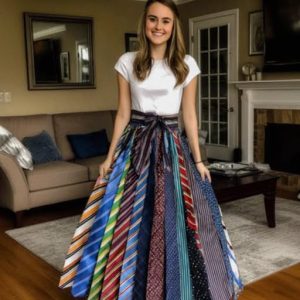Ella Bleu Travolta was born on April 3, 2000, to actor John Travolta and the late actress Kelly Preston. Growing up in a family deeply connected to show business, Ella was exposed early to the rhythms of filmmaking, red carpets, and the public eye. Her first on-screen appearance came at the age of nine, when she appeared alongside her parents in the 2009 comedy film Old Dogs. While “Old Dogs” did not launch her immediately into constant stardom, it served as an early introduction to what it means to perform and exist publicly in Hollywood.
After that early role, Ella took a long hiatus from acting during her adolescence. According to public accounts, she spent much of this time away from the spotlight, focusing instead on family life. In 2019 — a full decade after her debut — she reemerged on screen in The Poison Rose alongside her father. That return was more than a family cameo: it suggested a renewed personal interest in acting. Working again with a seasoned actor like her father gave her a comfortable—but still challenging—environment to reconnect with film work. This stage reflects the tension many children of famous actors face: balancing legacy and expectations with personal ambition.
But Ella’s creative ambitions did not remain confined to acting. During the COVID-19 pandemic, she began experimenting with songwriting. As she later told media outlets, she would capture melodies or lyrics as voice memos on her phone, then sit down with her ukulele to transform those ideas into more full-fledged songs. Encouraged by her father, she decided to pursue these pieces seriously — not as a hobby, but as part of a possible music career. This shift marked a turning point: Ella began evolving from “actor’s daughter” toward a more autonomous artist with her own voice, exploring emotional themes, personal loss, love, and healing through her songs.
In 2024, Ella released her debut EP Colors of Love — a six-song project that stands as a tangible expression of her musical identity. Among the songs is Little Bird, a tribute to her mother, which reflects her use of music not just for performance, but for personal processing of grief and memory. In interviews, she described acting and music as two sides of the same creative coin — the first more structured and collaborative, the second more solitary and intimate. Through this EP and its associated content, she gave audiences a glimpse into her emotions and vulnerabilities, signaling that she is crafting an identity grounded in authenticity rather than mere celebrity heritage.
Alongside her work in film and music, Ella has also begun establishing herself in the fashion and modeling world — another outlet for self-expression. She walked in a runway show at New York Fashion Week (for designer Karl Lagerfeld) in 2022, demonstrating her willingness to move across different facets of entertainment. Since then, she has appeared at major fashion events, front rows, magazine shoots, and campaigns — cultivating a public image that merges elegance, youthful edge, and personal flair. For Ella, modeling doesn’t seem like a diversion, but another dimension of creative expression — a way to shape style, presence, and identity beyond scripted roles and songs.
What stands out about Ella’s journey is the blend of legacy and self-determination. Yes — she began life with a famous surname and early exposure to Hollywood. But rather than simply riding that inheritance, she appears to be actively exploring different artistic paths: acting, music, fashion. She expresses a desire to create art on her own terms, embracing vulnerability through songwriting, experimenting with style and identity through modeling, and remaining open to the collaborative demands of film. She describes her father as both mentor and supporter — someone whose guidance she values, especially as she navigates opportunities and challenges.
As of now, Ella Bleu Travolta remains early in her adult career. She is not yet widely considered a major “star” in her own right — but she is far more than a celebrity child coasting on name recognition. Instead, she embodies what many second-generation artists aspire to: the possibility of merging inherited opportunity with personal talent and vision. Her path is not predefined solely by her last name; she seems genuinely invested in discovering and building her own creative identity, across multiple mediums, with depth and intention. For now, she is a young artist in formation — one whose future will likely continue evolving as she explores new projects, refines her craft, and learns to define “success” on her own terms.




